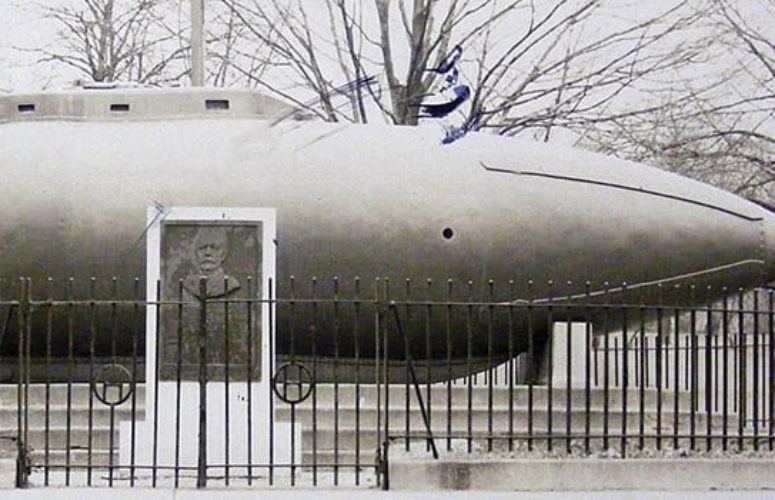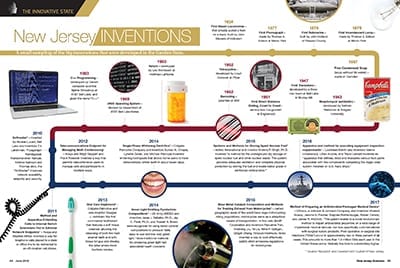
New Jersey Inventions
A small sampling of the big innovations that were developed in the Garden State.
On Jun 18, 20181824
First Steam Locomotive – that actually pulled a train on a track, built by John Stevens of Hoboken
1877
First Phonograph – made by Thomas A. Edison at Menlo Park
1878
First Submarine – built by John Holland of Passaic County
1879
First Incandescent Lamp – made by Thomas A. Edison at Menlo Park
1897
First Condensed Soup (soup without its water) – made in Camden
1943
Streptomycin (antibiotic) – developed by Selman Waksman at Rutgers University
1947
First Transistors – developed by a three-man team at Bell Labs in Murray Hill
1951
First Direct Distance Dialing, Coast to Coast – service was inaugurated at Englewood
1952
Barcoding – patented at IBM
1952
Tetracycline – developed by Lloyd Conover at Pfizer
1963
Valium – developed by Leo Sternbach at Hoffman-LaRoche
1969
UNIX Operating System – devised by researchers at AT&T Bell Labortories
1983
C++ Programming – developed by Danish computer scientist Bjarne Stroustrup at AT&T Bell Labs, and given the name “C++”
2010
Softrouter* – invented by Alcatel-Lucent, Bell Labs and inventors T.V. Lakshman, Thyagarajan Nandagopal, Ramachandran Ramjee, Krishan Sabnani and Thomas Woo, the “Softrouter” improves network scalability, reliability and security.
2011
Method and Apparatus Extending Calls to Internal Switch Extensions Out to External Network Endpoints* – Avaya and Stephen Milton invented a way for telephone calls placed to a desk or office line to be redirected to an off-location cell phone.
2012
Telecommunications Endpoint for Managing Multi-Conferencing* – Avaya and Birgit Geppert and Frank Roessler invented a way that permits teleconference users to manage calls and participants in multiple ways.
2013
Oral Care Implement* – Colgate-Palmolive and sole inventor Douglas J. Hohlbein: the first commercial toothbrush that features a soft tissue cleanser, allowing the cleansing of both the hard enamel teeth and soft-tissue tongue and cheeks, the latter where more bacteria resides.
2014
Single Phase Whitening Dentrifice* – Colgate-Palmolive Company and inventors Suman K. Chopra, Lynette Zaidel, and Michael Prencipe invented whitening toothpaste that allows home users to have demonstrably whiter teeth in about seven days.
2014
Green Light Emitting Pyrotechnic Compositions* – US Army ARDEC and inventors Jesse J. Sabatini, Ph.D., Jay C. Poret, Ph.D., and Russell N. Broad were recognized for using boron carbide compositions to produce “safe, easy-to-use and low-cost green light.” More traditional methods for producing green light had associated health concerns.
2015
Systems and Methods for Storing Spent Nuclear Fuel* – Holtec International and inventor Krishna P. Singh, Ph.D. invented “a method for the underground dry storage of spent nuclear fuel and other nuclear waste. The system provides adequate ventilation and complete physical protection by storing the fuel and waste below grade in reinforced vertical silos.”
2015
Base Metal Catalyst Composition and Methods for Treating Exhaust from Motorcycles* – certain geographic areas of the world have large motorcycling-riding populations; motorcycles serve as a ubiquitous means of transportation. In this vein, BASF Corporation and inventors Pascaline Tran, Xinsheng Liu, Ye Liu, Mike P. Galligan, Qinglin Zhang, Hiroyuki Horimura, Akiko invented a way to cost-effectively satisfy strict emissions regulations for motorcycles.
2016
Apparatus and method for executing equipment inspection requirements* – Lockheed Martin and inventors Valerie Underwood, Lillian Andres, and Travis Lenhart invented an “apparatus that defines, tests and evaluates various fault paths associated with the components comprising the Aegis radar system installed on U.S. Navy ships.”
2017
Method of Preparing an Antimicrobial Packaged Medical Device* – Ethicon, a Johnson & Johnson Company, and inventors Howard Scalzo, Jerome A. Fischer, Stephen Rothenburger, Robert Cerwin, and James R. McDivitt: “This patent relates to a novel revolutionary method to impart antibacterial properties on a wide range of implantable medical devices, but was specifically commercialized with surgical suture products. Post-operative or surgical site infections (“SSIs”) occur in approximately two to three percent of all cases. This amounts to more than 1.5 million SSIs each year in the United States alone. Globally this total is substantially higher.
* Source: Research and Development Council of New Jersey
Related Articles:







